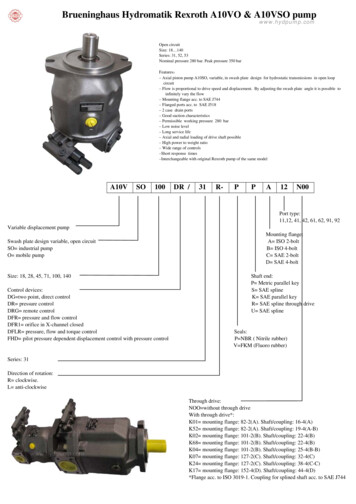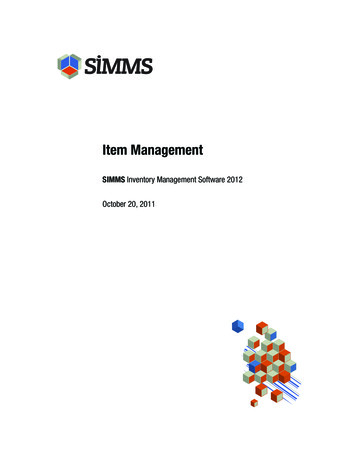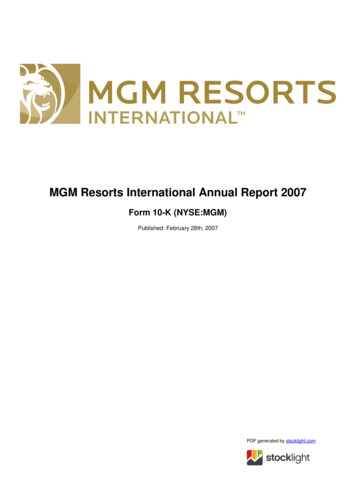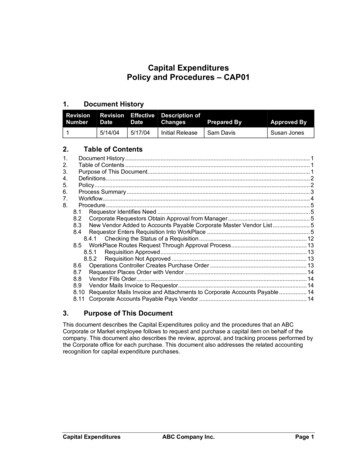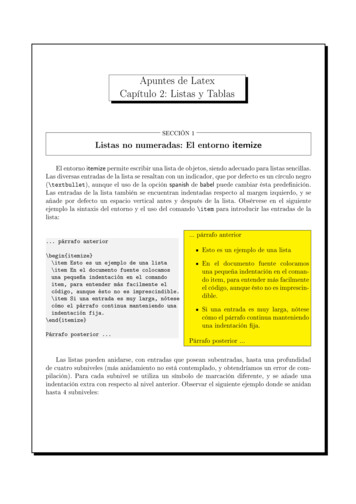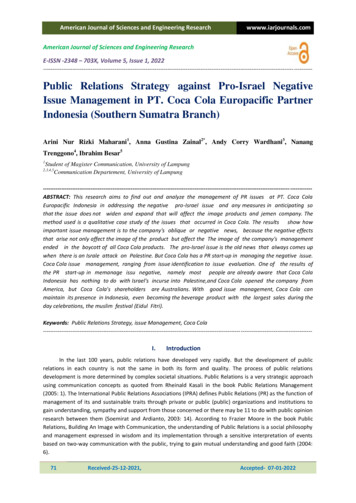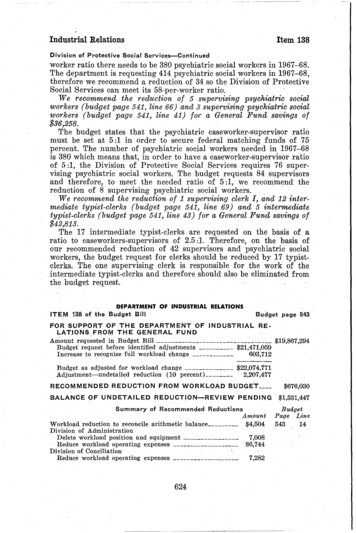
Transcription
Industrial RelationsItem 138Division of Protective Social Services-Continuedworker ratio there needs to be 380 psychiatric social workers in 1967-68.The department is requesting 414 psychiatric social workers in 1967-68,therefore we recommend a reduction of 34 so the Division of ProtectiveSocial Services can meet its 58-per-worker ratio.We recommend the rednction of 5 supervising psychiatric socialworkers (budget page 541, line 66) and 3 supervising psychiatric socialworkers (budget page 541, line 41) f01' a General Fund savings of 36,258.The budget states that the psychiatric caseworker-supervisor ratiomust be set at 5:1 in order to secure federal matching funds of.75percent. The number of psychiatric social workers needed in 1967-68is 380 which means that, in order to have a caseworker-supervisor ratioof 5 :1, the Division of Protective Social Services requires 76 supervising psychiatric social workers. The budget requests 84 supervisorsand therefore, to meet the needed ratio of 5 :1, we recommend thereduction of 8 supervising psychiatric social workers.We recommend the reduction of 1 snpervising clerk I, and 12 intermediate typist-clerks (budget page 541, line 69) and 5 intermediatetypist-clerks (budget page 541, line 43) for a General Fund savings of 42,813.The 17 intermediate typist-clerks are requested on the basis of aratio to caseworkers-supervisors of 2.5 :1. Therefore, on the basis ofour recommended reduction of 42 supervisors and psychiatric socialworkers, the budget request for clerks should be reduced by 17 typistclerks. The one supervising clerk is responsible for the work of theintermediate typist-clerks and therefore should also be eliminated fromthe budget request.DEPARTMENT OF INDUSTRIAL RELATIONSITEM1 8of the Budget BillBudget page 543FOR SUPPORT OF THE DEPARTMENT OF INDUSTRIAL RELATIONS,FROM THE GENERAL FUNDAmount requested in Budget Bill 19,867,294Budget request before identified adjustments 21,471,059Increase to recognize fun workload change603,712Budget as adjusted for workload change 22,074,771reduction (10 percent)2,207,477Adjustment-undetail dRECOMMENDED REDUCTION FROM WORKLOAD BUDGE'L 676,030BALANCE OF UNDETAILEO REDUCTION-REVIEW PENDING 1,531,447Summary of Recommended ReductionsAmountWorkload reduction to reconcile arithmetic balance 4,504Division of AdministrationDelete workload position and equipment7,008Reduce workload operating expenses 86,744Division of ConciliationReduce workload operating expenses -7,282624BudgetPage Lin'354314
Industrial RelationsItem 138Department of Industrial Relations-ContinuedDivision of Industrial AccidentsDelete workload contract position and other expensesDivision of Industrial SafetyDelete workload positionsReduce workload operating expenses .Division of Industrial WelfareDelete workload position '. Reduce workload operating expensesDivision of Labor Law EnforcementDelete workload positionsReduce workload operating expensesReduce workload equipmenLDivision of Apprenticeship StandardsReduce workload operating expensesReduce workload equipment ,------------Delete 3 administrative and workloadadjustment positions:1 Assistant chief1 Assistant intergroup coordinator1 Information officerDivision of Labor Statistics and Research. Reduce workload operating expensesAbolish Employment and Payroll StatisticsSection (32 state employee positions)Division of Fair Employment PracticesReduce workload operating 549695,97055042S'ummary of Policy Options1. Fund the support of the Division of Industrial Accidents by a premium basedassessment of workmen's compensation insurance carriers and equivalent assessmentof self-insurers. Legislation is required. Potential General Fund savings of 7.2million annually.2. Fund the support of the Division of Industrial Safety by a premium basedassessment of workmen's compensation insurance carriers and equivalent assessmentof self-insurers. Legislation is required. Potential General Fund savings of 3.9million annually.3. Reorganize the Division of Industrial Welfare eliminating the Industrial Welfare Oommission,. set minimum wage for women and minors in statute and tie tocost of living. Legislation is required. General Fund savings averaging 40,000 annually.Or:Abolish Division of Industrial Welfare and assign functions to Division of LaborLaw Enforcement. Legislation is required. Potential General Fund savings of 100,000 annually.4. Withdraw state support from promotional aspects of the apprenticeship prograIl). Potential annual General Fund savings of 1.5 million.GENERAL PROGRAM STATEMENTThe Department of Industrial Relations is the state's nearest counterpart of the federal Department of Labor and its mission is to protect,promote and develop the welfare of the wage earner, to improve hisworking conditions .and to advance his opportunities for .profitableemployment.To accomplish this mission, the department is organized into sevenoperating divisions, two staff services divisions and one division wl;tichis a public services. enterprise funded entirely through its own operation. Beca:use of the manner of its funding, this last division, the StateCompensatIOn Insurance Fund, does not appear in the department's625
Industrial RelationsItem 138Department of Industrial Relations-Continuedsupport budget. In addition there are units within each of the staffservices divisions which are involved in the execution of tasks in directsupport of the accomplishment of the department's statutory mission.The department and eight of its divisions derive their existence andfunctions through statutory authority from Division 1, Chapters 1-7,of the Labor Code. Two other divisions within the department, theDivision of Administration and the Division of Conciliation, have beenestablished administratively to provide for housekeeping, accountingand personnel functions by the former and more efficiimt service tomanagement and labor in the case of the latter.The department's growth in personnel and cost from fiscal year1963-64 through the proposed 1967-68 fiscal year is shown in Table 1.A four-year comparison of divisional staff and cost increases is contained in Table 2.Table 1ActualAct1tal1963-64-1964--65Positions1302.1Cost 14,325,130Percentageincrease overprior year:PersonnelCost* BeforeActual1965-661473.9 16,806,7011555.6 81722.9 21,755,2341720.1 22,219,858*10.9%17.9%2.1%5.5%9.7%workload adjustments and undetailed 10 percent reduction.Table 2Four-Year Comparison by ost48.7% onPositionsGostPositionsGostAdministration -------- 51.7 1,880,58776.9 3,005,163Conciliation 19.120.1278,401225,748Industrial Accidents 463.34,740,430587.16,976,772Industrial Safety 251.42,722,677312.03,911,304Industrial Welfare ---- 77.8738,37499.41,100,498Labor Law Enforcement s* 137.71,296,541217.02,397,284 57.6Labor Statistics andResearch ----------- 81.0641,473110.6952,955 36.5Fair Employment.Practices ----------- 41.4481,56553.4667,356 29.0Total 1,302.1*'Without federally fundedpositions and theirreimbursed support -- 137.7 14,325,130 1,128,4661,722.9 21,755,234 32.5188.4 1,747,756 36.8%84.948.538.651.854.8%The organization of the Department of Industrial Relations is unusual in that the chiefs of seven of the statutory divisions are Governor's appointees in addition to the director of the department; thus,it is conceivable that decisions on matters of policy disagreement between the director and his division chiefs or among division chiefswill be referred to the Governor's office for action. In addition, one of626
Industrial RelationsItem 138Department of Industrial Relations-Continuedhis division chiefs, the Administrative Director of the Division of Industrial Accidents, now receives a larger salary than does the directoras a result of legislation enacted in 1965. There is little logic for thisorganizational feature but it exists largely because of historic labororganization patterns.In prior analyses of this budget item, recommendations. have beenmade relative to reorganization of two of the divisions which wouldresult in efficiencies and economies of operation without reduction ofservices as well as recommendations relative to studying the possibilityof funding the operations of two other divisions from a source otherthan the General Fund. These recommendations will appear in the portions of this analysis which deal directly with the division or functionaffected.ANALYSIS AND RECOMMENDATIONSThis department's total proposed support expenditure for the budgetyear before workload adjustment and undetailed 10% reduction is 22,375,132 and is funded as follows:SourceAmountGeneral Fund 21,471,059Dept. of Employment Contingent Fund59,417Federal MDTA funds689,382Reimbursements for services '-55,274Included in the budget prior to any adjustment are proposals forextending a net total of 33.4 positions established administratively inthe current year into the budget year and 1.1 proposed new positions.The 1967-68 Governor's Budget proposes a General Fund level ofprogram of 22,074,771, which includes 603,712 to reflect workloadincreases. Upon application of a 10-percent reduction, the Budget Billpropo'ses an appropriation of 19,867,294.Weare advised that the workload adjustment provides for 22 newpositions with a personal services cost of 202,615, increase in operatingexpenses of 359,433 and equipment expenditure increases of 41,664.We can identify all but 1,625 of the personal services increases and 2,879 of the equipment increases. These two discrepancies we understand are due to the problems associated with working between thebudget without adjustment and adjusted budgets in that in the firstinstance a staff benefit for two positions was inadvertently left in theadjusted budget and in the second instance, additional equipment allowed in the workload budget remained after initial decisions on newand replacement equipment were made by the Department of Finance.We recommend that the adjusted budget be reduced by 1,625 inpersonal services and 2,879 in equipment expenditures.The amount of 1,625 of staff benefits for nonexistent positions isnot required.We cannot identify the equipment for which the 2,879 is requestedand cannot recommend inclusion of that amount without an evaluationof its purpose and need.627
Industrial RelationsItem 138Department of Industrial Relations-ContinuedDivision of Administra,tionThis division is responsible for the administration and planning associated with the execution of departmental policies and for all thehousekeeping functions of the department which include rent, postage,utilities, personnel and accounting. In addition it is responsible for thestatutory function of administering the workmen's compensation plansof self-insurers.The division will continue to provide housekeeping and other logisticsupport services to the eight operating divisions at current-year levelsin the budget year as well as, administering the audits of the selfinsurers workmen's compensation insurance programs.This division's budget before adjustment is 3,020,419. Of thisamount 3,000,276 is funded from the General Fund and the workloadadjustment of 200,413 increases this amount to 3,200,689. Weareadvised that the workload adjustment figure includes one clerical position with personal service costs of 5,102, increased operating expensestotaling 193,405 associated with the 22 new positions and opening twonew branch offices, one in POlI).ona for Industrial Welfare and Ap prenticeship Standards and the other in Martinez for Labor Law Enforcement and Apprenticeship Standards, and the equipment requiredfor the new position at 1,906.The clerical position is requested on the basis of workload increaseoccasioned by the additional staff employed by the department. It isrepresented that in the budget year there will be a net gain of 48departmental positions.In addition the division is providing personnel, services for the SanFrancisco Bay Conservation and Development Commission and thefederally reimbursed MDTA positions in the Division of ApprenticeshipStandards.We recommend deletion of this position, restllting in a total savingsof 7,008 in personal services and eq1lipment costs.The 48-position net increase presented in justification material supplied to us for the new clerical position was based, on the anticipationthat the workload budget would include all the positions the departmentwas requesting. However, the workload budget only has a portion ofthe positions resulting in a net decrease of 20 positions rather than anet increase of 48.,It does not appear that the division has been receiving reimbursements from other small state agencies for services rendered, yet thisdivision includes such services as justification for workload increases.We recommend that the department execute a reimbursement agreement with all such small agencies to whom it provides services in O1;derthat these workload increases be properly charged.The division's workload budget for operating expenses totals 2,579,082 and the workload increase is 193,405, an 8.1 percent increase,This increase is based upon the division's, estiml;ltes of increasingpostal costs, telephone communications, rent, building maintenance,general expenses and moving' expenses for the entire departmental or-628
Item 138Industrial RelationsDepartment of Industrial Relationsr-Continuedganization. A number of these xpenses increase in relationship to thenew positions.'We recommend that the worlcload increase in operating expense bereduced to 106,661, resulting Vn a savings of 86,744.In our review of this workloll;d increase we note what appears to bean inconsistency iIi that increases in general expense and communications are. included for new positions for which funds are not budgeted.A review of the workload justification material clearly indicates that,although funds for requested positions are not included in the adjustedworkload budget, funds for operating expenses for those positions havebeen included.Division of ConciliationThis divisionis responsible for the promotion bf sound labor relationswithin the state andme'ets this objective through the mediation services it stands by to' render at either party's request. Similarly it conducts elections and/or card checks to determine organizational representation by labor if requested. It also has mandatory obligations of asimilar nature in connection with the various statutory transit authorities in the state.The division will maintain the availability of its services to laborand management for investigation, mediation and other consultiveservices relative to labor disputes at current-year levels. Numericallythe caseload of disputes, elections and consultive services has remainedquite constant but the man-hours expended in these services is increasing. .The'division's budget before workload adjustment is 282,718, andwe are advised that the adjustment of 10,047 occurs in operatingexpense.We recommend that the workload adjusted budget of this divisionbe reduced to 285,483, resulting in a savings of 7,282.Our review of this adjustment for workload reveals that it is basedupon an increase in staff for which funds were not budgeted.Division of Industrial AccidentsThe Workmen's Compensation Appeals Board and the referee staffin this division are responsible for the adjudication of workmen's compensation claims. The remainder of the staff is employed in providinglogistic support of that function and performing tasks, statutory andotherwise, related to workmen's compensation.The division will continue its adjUdication of disputes of workmen'scompensation insurance and the revision and adjustment of its procedures, forms and reports as experienced under the reorganization ofthe division, following the enactment of Chapter 1513, Statutes of 1965,is acquired and evaluated. New filings of claims in the first five monthsof fiscal year 1966-67 have increased by 7 percent over the comparableperiod of fiscal year 1965-66, and the pending caseload is up 1.5 percent over the same period.The budget of the division prior to workload adjustment is 7,163,212and we are advised that the adjustment amounts to 86,521 and in629
Industrial RelationsItem 138Department of Industrial Relations-Continuedcludes three associate counsels and a supporting clerical position witha personal services cost of 48,701, operating expenses of 34,213 and 3,607 of equipment costs.Two of the associate counsel positions and the one supporting clericalposition requested are justified by the division on the basis of increasesin workload at the legal information desks in Los Angeles as well as anestimated increase due to a statement appearing on a new form developed as a result of legislation enacted in 1965 (Chapter 1513, Statutesof 1965, effective January 15, 1966). The new form invites the claimantsto contact division staff at various listed offices.We recommend approva of these 3 workload positions.Another associate counsel position is requested on the basis that trueexperience and evaluation of actual needs of the Workmen's Compensation Appeals Board prior to its reorganization did not exist and nowit is apparent the board required additional supporting staff in order tocarry out its function properly.We recomme;nd approval of this workload position.The adjusted workload request for operating expenses is 404,321and a review of the increase of 34,213 indicates a 1,200 item for flags,a 300 item for costumers and an item of 11,521 for services of a statepoliceman to act as a guard in the reception hall at the Los Angelesoffice.We recommend that the operating expense budget as adjusted forworkload be reduced to 391,420 resulting in a savings of 12,901.The amount requested for flags is the result of a typographical errorand the agency advises the correct figure is 120; thus a savings of 1,080 is indicated. In respect to the item on costumers (coat- and hatracks) a similar amount of 300 was requested in the current year'sbudget. It is unlikely that this expense should be continued on anannual basis and we have included its deletion in the reduction above.The request for 11,521 to reimburse the Department of GeneralServices for a specially detailed state policeman to provide protectionagainst the likelihood of an assault or an attempted assault upon persons in the office or in the reception hall at the Los Angeles office isprecedent setting. While it may be true that tempers and emotions ofindividuals involved in matters to be adjudicated by the division becomeinflamed and high, we do not believe the presence of a uniformed policeman within the hall would deter such persons from precipitous actions.It is understood that under present conditions the state police on regular duty within the building can answer a call for assistance withinone minute. In view of the circumstances we have recommended thatthis service not be funded.We have reviewed the equipment schedule and concur in the need forthe amount requested in the workload adjustment.The reorganization referred to above had as its primary objective thereduction of extensive litigation in the field of workmen's compensation.One method of achieving this objective is through the activities of thelegal information staff referred to above.630
Industrial RelationsItem 138Department of Industrial Relations-ContinuedPOLICY OPTIONOn a number of occasions in the past we have recommended inour analysis of the budget consideration of an alternative method offunding the support of this division. We again offer for considerationthe possibility of relieving the General Fund of this annual everincreasing expenditure for support of the adjudication processes ofworkmen's compensation.This savings of approximately 7.2 million in the budget year couldbe achieved by legislation which would permit a premium based assessment of workmen's compensation insurance carriers and an equivalentassessment of self-insurers.Some 27 states have adopted methods of self-financing their workmen's compensation programs; in all cases the costs of the program arepaid directly or indirectly by the employers. In 19 states the law establishes a maximum percentage of total premiums or claims beyond whichassessment cannot be levied.This policy option, if adopted, would transfer the support of theadjudication process in respect to workmen's compensation claimsarising out of injuries or death suffered in the course of employmentfrom the state to employers. Also the cost of the agency would beequitably distributed among employers on the basis of their relative useof its services.Division of Industrial SafetyThis division's responsibilities include all the inspection and enforcement aspects of insuring a safe place of employment for all the workforce of the state .The division will maintain the same level of service within the workload budget as in the current year. Increases due to new installations inthe field of elevators, pressure vessels and oil field activities will be metby new positions proposed in the workload budget. While California'swork injury rate declines to its lowest level in history (31.3 injuriesper 1,000 workers) in 1965, the current statistics indicate injuries areup 8.4 percent in the first seven months of 196'6. The work force increased by 4.8 percent in this seven-month period.The budget for the division prior to the workload adjustment is 4,015,636. The workload adjustment is 140,258 and we are advised itconsists of one senior safety engineer (mineral), six safety engineers(two elevator, three pressure vessel and one industrial) and two clericalpositions with a personal services cost of 86,289, operating expensesof 50,270 and equipment costs of 3,699.The basis for the request of the senior engineer (mineral) is to provide supervision for four mineral safety engineers in northern California. This supervision is now provided by the supervising engineer(mineral) in the San Francisco headquarters office.We recommend that this requested position be denied resulting ina savings of 12,553.We do not believe the addition of a senior safety engineer forsupervision of four journeyman level engineers is warranted. Thesouthern California area now has 1 senior safety engineer position631
Industrial RelationsItem 138Department of I ndustrial Relations-Continued'. ,.(mineral) supervising 10 safety engineers (mineral) ; thus, the span ofcontrol for the supervising engineer position, although on" two levels,is not considered beyond its capability.Weare concerned by the department's concept of specializationwhich has resulted in the abolishment,in the current year, of theformer supervisory position of district engineer, a generalist, and substituting therefor the senior engineer, a specialist. In the current year22 district engineer positions were changed to senior engineers; nochange in personal services costs was involved but the concept of asingle district engineer supervising all the safety engineers withinsmaller contiguous geographical districts regardless of specialty waschanged to the situation in .which the specialist is now supervised bya senior engineer in his specialty who may be located several hundredmiles distant. We do not believe this' recent· change results in eitherefficiency or economy except in metropolitan areas where, in mostcases, the entire specialist group work out of the same office. It resultsin a condition in which, although several diffiereri.t specialists workout of the same office, each is responsible for his performance to a different senior engineer at an even different location. Under such circumstances the solution of safety problems within that geographic arealacks coordination and the general overall level of ervice suffers.Indeed, it is quite possible under these circumstances for three different safety specialists to call upon a single place of employment withinthree successive days. This may be considered as harassment of anemployer and at the least a duplication of service and such situationscan be avoided with the coordination responsibility of district orarea supervision.In order to properly develop Career planning within the division itwould appear that rather than continuing a narrowing of competencyin the field of safety, the individual should be required to broaden hisexperience and competency level. Further the specialist concept inhibitsthe flexibility of the division to react to a' varying workload.We recommend that the division review this problem of organizationand supervis01'Y responsibilities in the nonmetropolitan geographicareas to insu.re the pilblic receives the most efficient and economical service within the capability of staff at these locations.,The request for six safety engineers is based upon formulas ih thecase of the elevator and pressure vessel specialists and upon the increase in the number of places of employment' and the rise in disablingwork injuries in agriculture for the industrial specialist.We recommend inclusion of these positions in the workload adjustment.Two clerical positions are requested,' one in Los Angeles and one inSan Francisco. The Los Angeles position is proposed for the administration section to act as a receptionist, giving information of a routinenature and referring technical questions to the proper section and ingeneral assisting the supervising clerk position as may be required. TheSan Francisco position is requested for the headquarters constructionsection to meet an increased workload of two years' duration which632
Industrial RelationsItem 138Department of Industrial Relations-Continuedinvolves the revision of Articles 9 and 10 of the construction safetyorders. The requested position will be required to perform the usualoffice assignments of a position of this classification.We recommend that the clerica-l position reqttested for the Los Angeles office be deleted resulting in a savings of 5,102 and we recommend approval of the position requested for the San Francisco office.We believe the justification offered for the position in the LosAllgeles office results in an increased level of service. The division advises that the function is not presently assigned to anyone person butis the responsibility of several positions. We recommend that one ofthe clerical positions existing in the administration section be assignedspecifically to that work station and use other positions to cover duringmealtimeiil and vacations.The operating expenses, when adjusted for workload, reflect an increase of 50,270 and total 454,399. The detail indicates those costswhich can be attributed to new positions were determined on the basisof requesting 13 safety engineers.We recommend workload operating expenses be .reduced in theamount of 13,653.The reduction represents the excess funds over and above necessaryoperating expenses required to support the six safety engineers recommended for inclusion in the workload budget. As stated previously, wedo not believe that operating expense money should be budgeted fornonexistent positions.We recommendinclt6sion of the workload funds requested for eqt6ipment as necessary to support the positions included in the workloadbudget.POLICY OPTIONThe policy option offered in this instance parallels the option offeredin the case of the Division of Industrial Accidents appearing onpage 631 of this analysis in that we recommend consideration be givento funding the support costs of this division by a premium based assessment of workmen's compensation insurance carriers and an equivalent assessment of self-insurers. This option will require enabling legislation and if effected, would result in annual General Fund savings of 4 million.The statutory inspections of places of employment and enforcementof the safety orders by this division to insure safe working conditionsand the reduction of on-the-job injuries is an integral part of thestate's industrial accident program. Insurance carriers and nearly allof the larger employers also are engaged in this effort to achievesafe procedures and practices in employment. All these efforts are inthe accident prevention area and while the nonpublic efforts aredirected primarily to the issue of minimizing casualty losses of aspecific industry or employer, the state's efforts implement the publicpolicy of preventing accidents in industry in a manner similar to thatof promotion of safety on the highways by other public agencies. Bothprograms serve and achieve the same ends.633
Industrial RelationsItem 138Department of Industrial Relations-ContinuedThere is a recognized relationship between an employer's workmen'scompensation losses and the industrial safety or accident preventionprograms in that nine states fund their industrial safety programs bysome means of self-financing and in all these cases the cost is borneby the employer either through direct assessment or indirectly throughpremium assessment.The implementation of this policy option would place the supportof this function upon those who realize the benefits of industrial accident prevention and reduction programs.Division of Industrial WelfareThis division has as its responsibility the promulgation and enforcement of the minimum wage orders for women and minors and isengaged in inspection activities to insure that the working conditioIlBfor women and minors meet the requirements of those orders.The division's services
1. Fund the support of the Division of Industrial Accidents by a premium based assessment of workmen's compensation insurance carriers and equivalent assessment of self-insurers. Legislation is required. Potential General Fund savings of 7.2 million annually. 2. Fund the support of the Division of Industrial Safety by a premium based
